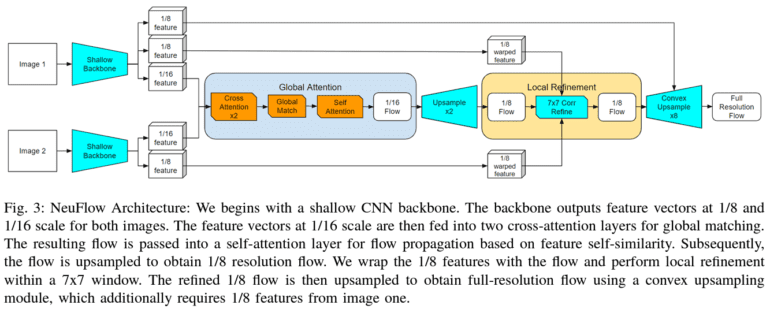- Northeastern University researchers introduce NeuFlow, a groundbreaking optical flow architecture.
- NeuFlow combines global-to-local processing and lightweight CNNs, minimizing computational burden while maintaining accuracy.
- The architecture’s innovative approach achieves significant speed improvements on hardware-constrained platforms.
- Real-world testing demonstrates NeuFlow’s superiority over state-of-the-art methods in both accuracy and efficiency.
- NeuFlow enables real-time operations on edge devices like Jetson Orin Nano, opening new possibilities for applications in robotics and drones.
- Its scalability and open-source nature empower further innovation and adaptation across diverse computer vision tasks.
Main AI News:
In the realm of computer vision, the quest for real-time, precise optical flow estimation has long been paramount. However, traditional methods have grappled with the trade-off between computational complexity and accuracy, particularly evident in edge computing scenarios. The emergence of deep learning offered promise but often at the cost of computational resources. This dilemma is especially acute in applications like autonomous vehicles and augmented reality, demanding instantaneous visual processing.
Enter NeuFlow, an innovative optical flow architecture crafted by Northeastern University scholars, poised to revolutionize computer vision. By melding global-to-local processing with lightweight Convolutional Neural Networks (CNNs), NeuFlow charts a new course. Its novel methodology adeptly captures large displacements and motion intricacies with minimal computational burden, a departure from the convention that has sparked intrigue and anticipation.
At the heart of NeuFlow lies its ingenious use of shallow CNN backbones for initial feature extraction across multi-scale image pyramids. This strategic step mitigates computational overhead while preserving crucial details for accurate flow estimation. Leveraging global and local attention mechanisms further refines optical flow. The initial global stage discerns broad motion patterns, while subsequent local layers focus on finer details, facilitating hierarchical refinement crucial for achieving precision without the heft of deep learning.
The real-world efficacy of NeuFlow speaks volumes. Outperforming several state-of-the-art methods on standard benchmarks, it delivers remarkable speedups. Tested on platforms like Jetson Orin Nano and RTX 2080, NeuFlow demonstrates an impressive 10x-80x acceleration while maintaining accuracy. This breakthrough heralds a new era, where complex vision tasks find fruition on resource-constrained platforms, thanks to NeuFlow’s prowess.
The compelling performance of NeuFlow extends beyond benchmarks. On Jetson Orin Nano, it enables real-time operations, unlocking possibilities for mobile robots and drones. Its scalability and open-source code empower further innovation across diverse applications, positioning NeuFlow as an indispensable asset for vision researchers and developers.
Developed by Northeastern University researchers, NeuFlow epitomizes a leap forward in optical flow estimation. Its astute balance between accuracy and efficiency tackles a longstanding challenge, ushering in new vistas for edge computing. By enabling real-time, high-precision motion analysis, NeuFlow not only expands current applications but also propels optical flow into uncharted territories within dynamic environments. This breakthrough underscores the transformative power of meticulous architectural design in surmounting hardware limitations, fostering a new wave of interactive computer vision applications.
Conclusion:
NeuFlow’s introduction signifies a paradigm shift in optical flow architecture, offering a potent blend of efficiency and precision. Its real-world performance benchmarks and scalability suggest a promising market potential, particularly in sectors reliant on edge computing and real-time visual processing. As NeuFlow continues to evolve, it’s poised to reshape the landscape of computer vision applications, unlocking new opportunities and efficiencies for businesses across industries.

